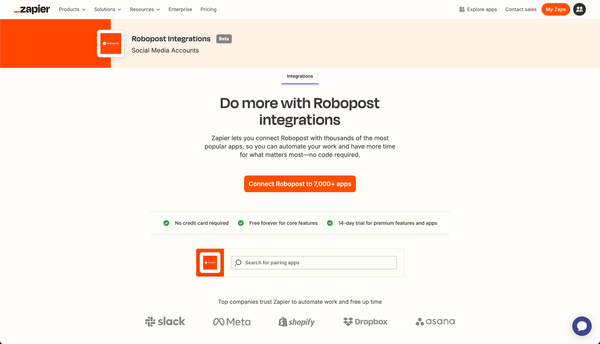Social Media Automation: Balancing Efficiency and Authenticity
Explore the balance between social media automation and genuine engagement to maintain authenticity and build meaningful connections.

In today's digital world, social media automation helps marketers boost their online presence and simplify their work. However, it's important to balance efficiency with authenticity to keep social interactions personal. This article explores how to use automation while keeping a personal touch, building real relationships, and maintaining engagement.
Key Takeaways
- Avoid Over-Reliance: Using too much automation can make interactions less personal and miss chances to connect in real-time.
- Enhance with Human Insights: Combining human insights with automated tools makes interactions more genuine and builds better relationships.
- Customize and Review: customize automated responses and check them regularly to keep communication relevant and flexible.
- Monitor and Adapt: Keep an eye on and update automation strategies to stay relevant and effective in the constantly changing social media world.
The Pitfalls of Over-Automation in Social Media
Losing the Human Touch
Automation tools help make interactions easier, but they can't show empathy or genuine interest like humans can. Without a personal touch, there can be a disconnect between brands and their audience, making it harder to build meaningful relationships needed for ongoing business.
The key is to use automation for routine tasks while keeping human involvement in customer interactions.
While automation can handle many interactions quickly, some moments need a human touch. Here are interaction types where human responses are essential:
- Personalized customer service questions
- Handling sensitive or complicated issues
- Having meaningful conversations
- Showing empathy and understanding
By recognizing these important moments, brands can use human responses strategically to stay authentic and build real connections.
Inflexible Responses and Missed Opportunities
Being too rigid can cause you to miss important opportunities. Automated responses are efficient but often can't handle the details of real-time interactions. For example, a set response to a common question might become outdated due to changes in URLs or company policies, leading to frustrated customers and a damaged brand image.
- Regularly check automated messages to keep them relevant.
- Update templated responses to match current events and your brand's voice.
- Use social listening to get feedback beyond what automated triggers can catch.
Automation should help improve engagement, not replace it. It's important to regularly review and adjust automated messages to stay in tune with current events and keep a consistent tone that connects with your audience. Automation can't capture all human emotions and sentiments. Ignoring this can make your communication strategy seem robotic and disconnected from your audience.
Dependency and Complacency Risks
Scheduling content in advance can be convenient, but it can also create a false sense of security. Marketers might rely too much on automation tools and forget to stay updated and responsive. This dependence can weaken critical thinking, creativity, and human decision-making, which can be bad for individuals and society.
Relying too much on automation can also lead to sharing outdated or inappropriate content, especially during crises or important events. It's important to actively manage and oversee automated systems to avoid these problems.
Understanding the limits of automation is crucial. AI can make processes easier, but it can't replace the detailed understanding and flexibility of human oversight. Ignoring user feedback is a common mistake that can lead to missed chances for improvement and a disconnect with your audience.
Striking the Right Balance: Automation with a Personal Touch
Integrating Human Engagement with Automated Tools
In social media, automation should support, not replace, human interaction. Combining human engagement with automated tools is key to keeping a real connection with the audience. This way, organizations can use automation efficiently while making sure the content feels personal and meaningful.
- Teach your team how to use automated tools with workshops and webinars.
- Focus on making automated content feel personal and relevant to each user.
- Adjust in real-time based on user interactions to improve engagement.
Automation can handle repetitive tasks, but the human touch adds empathy and context to content. This balance is good for user engagement and helps keep the brand's online presence strong.
Monitoring and Adjusting Automation in Real-Time
The fast-paced world of social media means automation needs constant monitoring and adjustment. Making changes in real-time is important to keep automated systems working well and staying relevant. Regularly checking key performance metrics like engagement rates, clicks, and conversions can show where to improve and guide updates to the automation strategy.
Here are some key steps for monitoring and adjusting automation:
- Regularly review automated interactions to catch negative feedback or valuable insights.
- Track performance metrics like traffic, bounce rates, and social media shares to see the content's value.
- Use data to make quick edits and improve machine learning algorithms for future use.
- Personalize automated responses to meet individual user needs, providing a high-quality experience.
By staying alert and adaptable, businesses can use automation to save time and build real connections with their audience.
The Sustainability of Social Media Automation
Long-Term Strategies for Effective Automation
Creating a solid content strategy for automation is key for long-term success. Combining your goals with areas suited for automation into a clear plan makes sure technology supports your business aims. This strategy should cover all stages of content creation and distribution:
- Research: Automate keyword searches or trending topics.
- Writing: Use AI tools for generating content.
- Editing: Use automated grammar and spell-checkers.
- Promotion: Automate social media posting schedules.
Picking the right tools is important, considering things like user interface, purpose, and how well they fit your content strategy. Automation should boost human skills, not replace them.
Ensuring Quality and Relevance Over Time
Using set-and-forget strategies for social media automation can be tempting. Keeping automated content high-quality and relevant is essential for long-term success. This requires ongoing monitoring and adjustments to meet changing audience expectations and industry trends.
To keep content fresh and engaging, stay updated on trending topics in your industry. This prevents your social media from becoming outdated or irrelevant. Additionally, ensure the quality of automated content by making sure it is grammatically correct, factually accurate, logically structured, and interesting.
While technology can increase efficiency, it can't replace human judgment. Regularly review automated content to ensure it matches your mission and maintains your brand's voice. Important posts should be manually approved before being shared.
To maintain quality and relevance of your content, use this checklist:
- Consistency Check: Ensure a consistent writing style.
- Accuracy Evaluation: Verify facts and data.
- Engagement Analysis: Check if the content is interesting and engaging to your audience.
- Brand Alignment: Make sure the content reflects your brand's voice and values.
Adapting Automation to Changing Social Dynamics
As social media changes, staying relevant means updating automation strategies to fit new trends. The rise of new platforms and changing user behaviors require a flexible approach. It's not just about keeping up with trends; it's about being ready to adapt and innovate.
- Recognize changes and be ready to respond
- Try out new tools and platforms
- Balance automated and personal engagement
The industry demands that social media teams stay alert and make room for trying new things. Regularly review and update automated systems to match current trends and audience expectations. This helps avoid over-automation and keeps your social presence dynamic and responsive.
Recognizing and Overcoming Over-Automation Syndrome
Identifying Signs of Excessive Automation
It's important to know when social media automation stops being helpful and starts hurting your brand's authenticity. Over-automation can show up in several ways, like lacking a personal touch in interactions or feeling disconnected from your audience. Here are some signs that your social media might be too automated:
- Repetitive and generic responses that don't address specific customer questions or comments.
- A drop in user engagement and feedback, showing a loss of interest due to impersonal content.
- No real-time interaction, with delayed or off-topic replies that miss current social conversations.
- Marketing teams becoming disconnected from customer conversations, leading to a lack of understanding of what the audience needs.
If you see these signs in your social media efforts, it's time to reassess and adjust. Balancing efficiency and authenticity is key to making sure automation helps rather than hurts your social media strategy.
Balancing Efficiency with Genuine Interaction
Using automation for efficiency should be balanced with the need for real interaction. Automation should help, not replace, human interaction, making sure every customer feels heard and valued. An automated response can acknowledge customer inquiries quickly, assuring them we received their message, but a personal follow-up is still essential.
- Acknowledge: Quickly acknowledge customer inquiries with an automated response to let them know their message has been received.
- Prioritize: Use automation to sort and prioritize messages, but ensure real people address concerns and engage in meaningful conversations.
While automation tools like Robopost can quickly create content and responses, they often miss the context and emotions that humans understand. Telling compelling stories and adding a human touch to interactions are crucial for connecting with audiences deeply. As we use AI and automation in our strategies, we must stay alert and make real-time adjustments to keep our human connections strong.
Creating a Dynamic and Responsive Social Presence
To keep your social media presence active and engaging, it’s important to understand and anticipate what your audience needs. This approach helps you interact in a timely and relevant way.
A/B testing is another useful strategy. By trying different types of content, captions, and posting times, you can find out what works best and make your posts more engaging. The aim is to create social media content that looks good and is meaningful to your followers.
When you have important updates or changes, create a special campaign to inform and excite your followers. If your message isn’t reaching enough people organically, consider investing in paid promotions to spread the word further.
Conclusion
It's important to find the right balance between automation and being genuine. Automation tools are great for keeping things consistent and efficient, like scheduling posts and handling responses quickly. However, you need to use them carefully to avoid becoming too robotic. Keeping a human touch in your interactions and staying responsive to current events is key. This way, you can create real connections with your audience, build strong relationships, and keep a social media presence that feels both heartfelt and effective. The aim is to help the social media manager work smarter, not to replace them, while still keeping the essence of social interaction.
